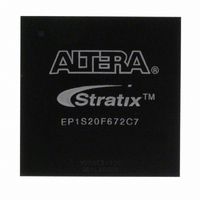EP1S20F672C7 Altera, EP1S20F672C7 Datasheet - Page 24

EP1S20F672C7
Manufacturer Part Number
EP1S20F672C7
Description
IC STRATIX FPGA 20K LE 672-FBGA
Manufacturer
Altera
Series
Stratix®r
Datasheet
1.EP1S10F780C7.pdf
(276 pages)
Specifications of EP1S20F672C7
Number Of Logic Elements/cells
18460
Number Of Labs/clbs
1846
Total Ram Bits
1669248
Number Of I /o
426
Voltage - Supply
1.425 V ~ 1.575 V
Mounting Type
Surface Mount
Operating Temperature
0°C ~ 85°C
Package / Case
672-FBGA
Family Name
Stratix
Number Of Logic Blocks/elements
18460
# I/os (max)
426
Frequency (max)
420.17MHz
Process Technology
0.13um (CMOS)
Operating Supply Voltage (typ)
1.5V
Logic Cells
18460
Ram Bits
1669248
Operating Supply Voltage (min)
1.425V
Operating Supply Voltage (max)
1.575V
Operating Temp Range
0C to 85C
Operating Temperature Classification
Commercial
Mounting
Surface Mount
Pin Count
672
Package Type
FBGA
Lead Free Status / RoHS Status
Contains lead / RoHS non-compliant
Number Of Gates
-
Lead Free Status / Rohs Status
Not Compliant
Other names
544-1113
Available stocks
Company
Part Number
Manufacturer
Quantity
Price
Company:
Part Number:
EP1S20F672C7
Manufacturer:
SHARP
Quantity:
3 509
Company:
Part Number:
EP1S20F672C7
Manufacturer:
ALTERA
Quantity:
528
Part Number:
EP1S20F672C7
Manufacturer:
ALTERA/阿尔特拉
Quantity:
20 000
Company:
Part Number:
EP1S20F672C7N
Manufacturer:
Harting
Quantity:
1 000
Company:
Part Number:
EP1S20F672C7N
Manufacturer:
ALTERA
Quantity:
3 000
Logic Elements
2–10
Stratix Device Handbook, Volume 1
Dynamic Arithmetic Mode
The dynamic arithmetic mode is ideal for implementing adders, counters,
accumulators, wide parity functions, and comparators. An LE in dynamic
arithmetic mode uses four 2-input LUTs configurable as a dynamic
adder/subtractor. The first two 2-input LUTs compute two summations
based on a possible carry-in of 1 or 0; the other two LUTs generate carry
outputs for the two chains of the carry select circuitry. As shown in
Figure
carry-in1 chain. The selected chain’s logic level in turn determines
which parallel sum is generated as a combinatorial or registered output.
For example, when implementing an adder, the sum output is the
selection of two possible calculated sums: data1 + data2 + carry-in0
or data1 + data2 + carry-in1. The other two LUTs use the data1 and
data2 signals to generate two possible carry-out signals—one for a carry
of 1 and the other for a carry of 0. The carry-in0 signal acts as the carry
select for the carry-out0 output and carry-in1 acts as the carry select
for the carry-out1 output. LEs in arithmetic mode can drive out
registered and unregistered versions of the LUT output.
The dynamic arithmetic mode also offers clock enable, counter enable,
synchronous up/down control, synchronous clear, synchronous load,
and dynamic adder/subtractor options. The LAB local interconnect data
inputs generate the counter enable and synchronous up/down control
signals. The synchronous clear and synchronous load options are LAB-
wide signals that affect all registers in the LAB. The Quartus II software
automatically places any registers that are not used by the counter into
other LABs. The addnsub LAB-wide signal controls whether the LE acts
as an adder or subtractor.
2–7, the LAB carry-in signal selects either the carry-in0 or
Altera Corporation
July 2005














